This post may contain affiliate links. We only recommend products and services we find to be high quality and beneficial. Thank you for supporting us. Our family thanks you!
We all have that whole foodie friend in our lives – the one who puts kale in everything and grinds their own flour before baking. Their lifestyle is admirable and something to be commended but seems a little far out for the average household.
Think again!
There are many reasons why milling your own flour is the best way to go. If you don’t already do it, it’s something you should look into – it’s not only for your foodie neighbor.
What is Just-in-Time milling? Say goodbye to buying stale bags of flour that have been sitting on a shelf for who knows how long. Now you buy whole grain einkorn berries here and when you are ready to bake, you throw the berries in your mill and the fresh flour comes out and is ready to be used for all your baking needs right when you need it!
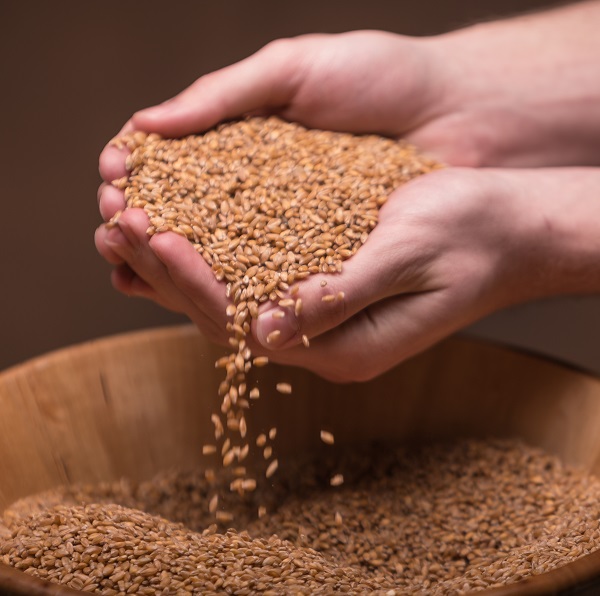
From Berries
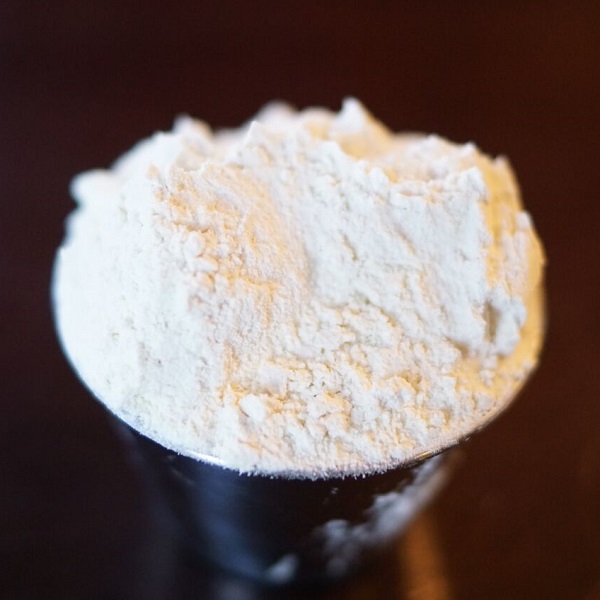
To Flour
Don’t have a flour mill? Keep reading to the end of this article to see an incredible deal we’ve put together for you!
So why would anyone take an extra step to grind their own flour when there are so many companies who would gladly do it for you? We’ve milled our at home flour for years, and it’s simply a way of life for us, and we love it.
Turns out, there are way more pros to grinding your own flour than cons.
It really comes down to four main things: taste, quality, health, and cost.
Freshly Milled Einkorn Flour Tastes Better
Gratefully, I grew up with a mother who ground her own wheat. We didn’t use anything as healthy as einkorn, but even so, I was spoiled. I remember eating wonder bread sandwiches at friend’s houses and going “What is this stuff holding the sandwich together? It tastes like soggy cardboard.” Luckily my mother had also managed to teach me some tact, and I never said anything like that out loud.
But it was clear to me. Whole wheat bread has so much more deep and complex flavor than white bread and einkorn bread has even more flavor than that.
Some of you may be thinking, “Ok fine, but why do I have to grind it myself? You can buy whole wheat flour if it means that much to you.” True. However, have you ever had this experience?
You make something delicious for dinner. Your senses are reeling and you are so excited when you realize there are leftovers! The next day at lunch you are so ready to have more of your masterpiece, but, for some reason, it just isn’t quite the same. It’s still good, but the freshly made flavor is gone.
Flour is the same. A lot of flavor is lost as flour sits. This is because it is susceptible to oxidation and rancidity. There is just something about freshly ground flour that tastes better.
It’s a noticeable difference. Dr. Stephen Jones, who is the director of The Bread Lab at Washington State said, “There are real flavors that are lost within a short time. We’ve done informal blind tastings, and the difference between flour that was freshly milled and flour that had been stored for a while was clear to everyone.” (Fresh Flour Power)
Try as they might, no flour company can match the outstanding flavor that comes into your baked goods when you grind your own flour. Even if you choose to sift your flour for better texture, you are going to retain so much more flavor than if you bought flour.
Just-In-Time Milling Improves Quality
Some people would like to bake with whole wheat flour but feel like, when they do, something in texture is lost. This is because, when grinding your own flour, you remove nothing. The bran, which is removed from all-purpose flours, is coarse and sharp and tends to cut through the gluten strands so that the bread becomes denser and less fluffy.
This has never been a big problem for us, but if you want to minimize that effect, you can sift your flour so that some of that is removed without removing everything that gives the bread flavor and nutrition.
When you grind your own wheat or einkorn, you can also decide how fine you want your flour. It can be anywhere from cracked wheat to a very fine powder. So you don’t have to sacrifice beautiful light breads, but if you’re looking for coarser flour or cracked wheat for hot cereal, you have that option without buying another bag of flour.
Freshly ground flour, because it hasn’t been sitting and compacting, is the absolute best in terms of bread-making quality. If you have any experience with baking from scratch, you will be able to tell that the quality of bread made from your flour is leaps and bounds ahead of commercial flour.
Freshly Milled Flour is More Nutritious
This is the no-brainer when it comes to grinding your own flour. Einkorn grain especially is packed with nutrients. Grinding your own flour is the way to get all of those nutrients into your body.
The minute berries are ground into flour, the loss of nutrients begins, and the longer it sits, the greater the loss. For maximum nutrient density, it’s best to grind flour as you use it. It only takes a few minutes to grind what to need and the benefits are unbelievable.
Commercial millers generally add ingredients you don’t want such as potassium bromate and Azodicarbonamide (used to make yoga mats).
Commercial millers do add nutrients in after they mill but nutrients that are processed in a lab and then added to your flour can never take the place of the naturally occurring nutrients that are in the flour you grind at home for immediate use.
Not to mention, you get to control what is removed. A little sifting for texture does not remove nearly as many nutrients as are removed from processed all-purpose flour. Trust me, it makes a huge difference.
Milling Yourself is Cheaper
Eating healthy very often costs more than we’d like, but in this case, it actually doesn’t have to. Generally speaking, whole berries cost less than flour because there is much less processing required. For our einkorn, that is definitely true. If you can grind your own flour, that means you can store berries instead of flour. Since berries store so much longer than flour, you can buy berries cheaper in bulk and store them until you’re ready to grind!
Choosing Your Grain Mill For Home Use
And now some of your are saying “But I don’t have a flour mill, and those aren’t cheap.” Often that’s true but to make your adventure into milling your flour all the more enjoyable, we’ve arranged a special opportunity that you may want to consider.
Wolfgang Mock is a grain mill engineer out of Germany. For over 40 years, he’s been designing and manufacturing flour mills for home use.
Wolfgang wants every household to have a mill so they can enjoy the benefits of fresh foods. He teaches classes and shows people how easy it is to mill flour and bake. It’s easier than most people every imagined, thanks to his grain mills.
His new Mockmill® line of mills culminates Wolfgang’s 40 years of engineering home mills with the finest yet most affordable mills on the market today.
Wolfgang has 3 flour mills, Mockmill grain mill attachment for stand mixers, and two counter top mills. Mockmill 100, and the Mockmill 200.
Mockmill Grain Mill Attachment for Stand Mixers – The grain mill attachment for stand mixers (KitchenAid, Kenmore). Easy to clean. Simple to use for milling just the amount of fresh flour you need for your recipe. The finest stone mill attachment for stand mixers on the market today.
We tested the Mockmill Grain Mill Attachment for Stand Mixers in our kitchen. It produced a nice, fine flour and it didn’t heat up. I really like the versatility and compact features of the Mockmill Grain Mill Attachment For Stand Mixers. It’s small enough to put on the shelf, out of the way. This stone mill is great for anyone who wants to mill their flour at home, and has a stand mixer.
If you are looking for higher capacity milling, and don’t want to tie up your stand mixer while you mill flour, you should consider the Mockmill 100 and Mockmill 200.
Mockmill 100 Grain Mill – An incredibly affordable grain Found here on our website , Wolfgang’s Mockmill 100 has the largest mill stones in the market, with a new patented housing made from “liquid wood”. It appears to be plastic but it’s actually 98% natural fibers. It makes the mill eco-friendly AND budget friendly!
Mockmill 200 Stone Grain Mill – Sold here. The Mockmill 200 is just like the Mockmill 100 only double the milling speed!
All three Mockmill models are available for purchase on our website. Click here to learn more about the Mockmills.
And you can use your Mockmill for milling more than just einkorn. The Mockmill can also be used to mill quinoa, corn, rye, oats, rice, barley, legumes, spices and many more.
Plus, if you’d like to sift your freshly milled flour to remove some of the bran, and make more of an all-purpose flour, here is a flour sifter you may want to consider…

Milling your flour at home is exciting when you consider all the possible creations and benefits. It’s a great idea if you plan to make einkorn a regular part of your life. Hopefully this information has been helpful as you embark on the journey.
Be sure to check out Wolfgang’s new line of mills on his website, and pocket the savings on the Mockmill 100 before the special pre-release price discount goes away.
If you have any questions or additional insights about milling flour, we’d love to hear about it in the comments.

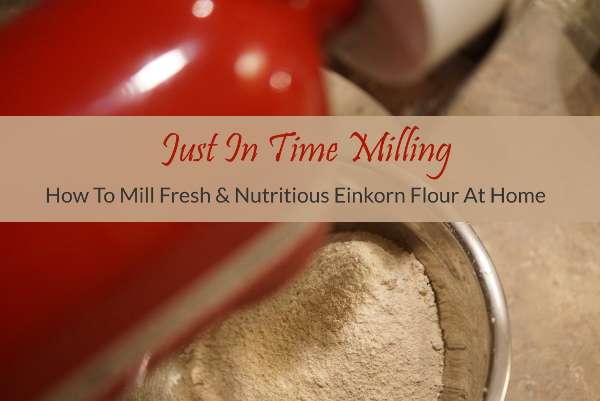
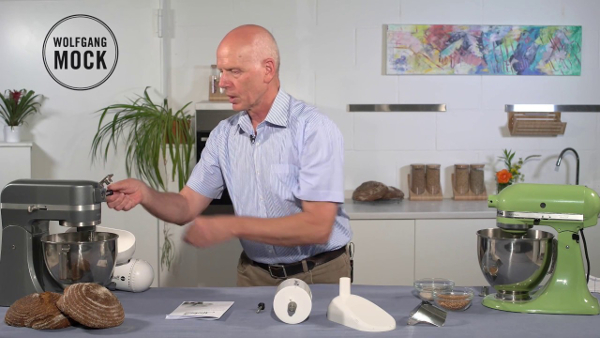

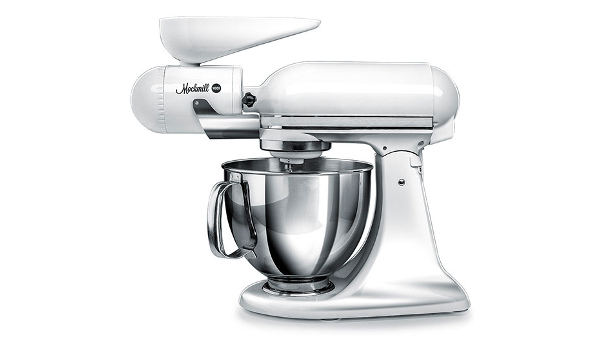
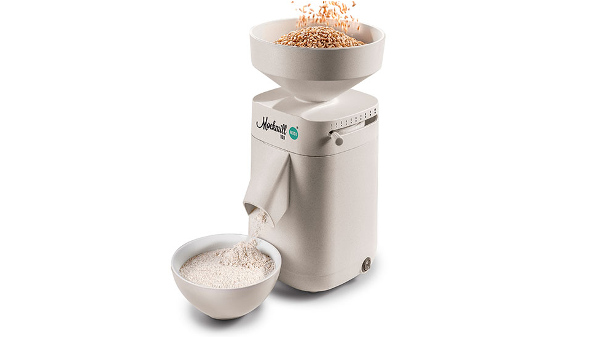
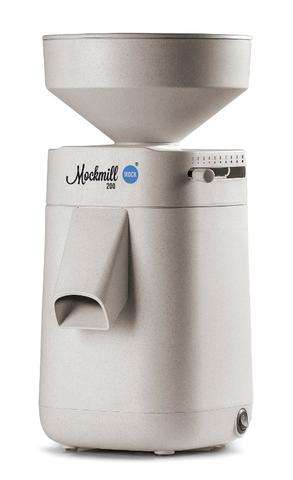
Here is some information that I have found that I would like to pass along..
I grind einkorn berries in a Mockmill 200 and then sift the flour through a
200 micron filter (avail. @ https://www.mannlakeltd.com/200-micron-filter-fine?list=Category%20Listing )
I have some digestion issues when eating to much coarse fiber and have found that the
einkorn/sifting is easy for me to digest, which is wonderful because I have not been able to eat ‘regular’ flour either white (gluten) or whole wheat flour for years and now have no issues..
I find that setting the Mockmill at its finest setting works well with just 1 milling but have found that
if I run the part of sifted flour that does not go through the sifter ( the brown fiber part) through
the mill a second time I get more fine [white] flour when I sift it again..
I also have tried the Mixmaster mill attachment (not the Mock Mill attachment) and it worked good to make flour, but it
heated up both the flour and the machine also it took forever to grind the berries (like 10 minutes or so to do a cup of flour), so if you value your time and don’t want to burn up your Mixmaster I recommend
that you use a dedicated mill…I also tried a Vitamix mill attachment and it didn’t grind the flour as fine as I prefer it even on the finest setting…
I am wondering what the best way to store the wheat berries is? Or where I can find more information on storage.
Hi Amber, if you are buying very large amounts, we have super pails for long term storage. If not, just make sure they are stored cool and dry and they should be fine. You can always freeze or refrigerate if those conditions are hard to come by.
Hi there! When will All purpose be back in stock? Thanks!
Hi Kerri, we don’t have an exact date. We are trying to move the processing in house and will make it available when the equipment is in place for that. I’d be happy to notify you when that’s all in place.
Amy updated information on availability of all your products (since we are in the middle of the Covid-19 pandemic ) so one can order ?
Hi Marla, we have plenty einkorn grain and whole grain flour. The all-purpose flour is out of stock but will be available probably next week. Thank you!
Your link to (Fresh Flour Power) does not show the referenced article. Would appreciate reading it.
thank you. check it now!
How can you ensure the wheat does not contain mycotoxins (not sure if I have the spelling correct). Apparently, zearalanone is created when wheat is exposed to moisture and creates a type of fungus. Typically, zearalenone concentrations are low in grain contaminated in the field, but increase under storage conditions with moisture greater than 30%–40%. Sorry for the complicated question, but it plays havoc with estrogen positive breast cancers.
Thanks!
Hi Debra, thank you for your questions. I don’t know specifically anything about this, but einkorn is a hulled wheat which protects it from a lot of the fungi and disease that plagues modern wheat. After it’s hulled, we always store it cool and dry to keep it from going bad.
I am wanting a home grinder but after reading reviews I feel more fused. Are u saying because we don’t have a
Commercial grinder we won’t have the best all purpose flour but it will be ok? I just started using einkorn flour making bread and guess I am asking after investing in a grinder and berries am I not going to have really good all purpose flour? Also how many times do u have to sift it? I use to grind my own wheat and make bread when the bread machines first came out. I think I still my grinder. Not sure of the name , Magic Mill, maybe? Anyway I am very interested in your grinder but would like more I formation. Thank u
Hello Dolores, thank you for your comment. Grinding your own flour will not produce all-purpose flour. All-purpose flour goes through several processing steps with industrial equipment to remove the bran and the germ. When you mill your own flour, the bran and the germ remain. It’s a whole grain flour, not a white flour. We like that because the bran and the germ is where all the nutrients are. If you want a consistency that more closely approaches all-purpose flour, you will want to do some sifting, but we like to keep all of it so we are getting all the flavor and nutritional benefits of whole grain flour.
After reading quite a few posts, I’m still a little confused on making all-purpose flour at home. Should I grind the berries on the flour setting and then sift? Or would it be better to grind at a pastry setting? Since I am grinding at home, how quickly will the freshly milled flour go rancid? And are there any recipes where sifting the bran out would not be a better option?
Hi Julie, true all-purpose flour requires commercial equipment. We just like to use the whole grain flour at home for pretty much everything. You can do some sifting to get something that more closely approaches all-purpose flour. A pastry setting will get you very nice fine flour. We recommend that you grind as needed. That is they way to get the most nutritional value out of the grain.
Our counter top MockMill came in the other day, such a dream at grinding the berries. Do we need to still sift the flour to remove the bran and germ for all purpose, or will it work the same being finely ground?
Hi Karen, we always just use it as is after grinding it very finely. It won’t be exactly like all-purpose but very good and much healthier. You could sift it, though, and that would make it more similar to all-purpose. Since we don’t usually sift, I don’t have a ton of expertise with that, but you may want to consider grinding it slightly less fine if you’re going to sift it. You could play around with it, though.
very interesting! I’m looking into this and would love the recipes. Never heard of Einkorn until a few day ago. Not sure if I want to buy the flour or grind my own.. Thanks for the information.
Hi Debbie, there are a lot of einkorn recipes online now that can help you get started. You can go here to see the recipes we’ve created. We always recommend grinding your own flour if possible. The health benefits and flavor is so much better and it can always be sifted if you want to make something that’s supposed to be lighter and fluffier.
Hi,
Just wondering if there is a difference in the flour fineness between the Mockmill and KitchenAid grain mill attachments?
Also, is there a grain mill out there for domestic use that produces the same result as a commercial flour mill in terms of extra fine flour or do I need to keep welding that muscle power when sifting?
Thanks!
Hi Natalia, the mockmill will definitely produce finer flour than the kitchenaid brand attachments, but the mockmill countertop mills that are launching soon are going to be even more efficient at producing extremely fine flour. You’re probably not going to get the same result as a commercial mill with any home mill on the market, but the mockmill countertop mills can get pretty close.
I have a Kitchenaid grain mill but I tends to take a long time and overheats my machine. I experimented using my magic bullet with the flat blade to make flour. I had already been using it to make oat flour but it works great with the Einkorn berries and, for the most part, better and faster than my KitchenAid.
I have begun sifting some of the flour I grind to get something closer to regular flour and I use the residual bran and germ to make Graham Flour for my graham crackers. My only problem has been finding the right adjustments for high altitude bread. Jenni at Einkorn has been great and so patient at helping me work on that.
Can the berries and milled flour be stored in glass air tight jars?
Hi Barbara, the most important thing is that the berries or flour be stored cool and dry. Airtight glass containers should be fine.
Thanks for the education on einkorn….luv learning. I think Whole Foods sells the berries…been looking forward to baking w einkorn for a long time. I think I read we can use sour dough starter….right?
Hi Barbara, yes einkorn can be used in or with a sourdough starter.
Can one use a Vitamix blender to mill?
Hi Brett, yes you can use a high power blender like a vitamix to mill flour. We have a few customers who use only that and they seem to be happy with it. It will produce flour that’s a little bit coarser than what you’d get from a wheat grinder, but it just comes down to your preference.
Hi,ley me know when this grind flour will be on ale again please,thanks,maggie
Hi Maggie, are you referring to the mockmill wheat grinder? We’ll be sure and let our readers know if they offer a special like that again.
Is it true that Einkorn flour does not need to be stored in the freeer as it only contains the endosperm and so will not go rancid?
Hi Linda, it’s true that the part of the einkorn that goes rancid has been removed. We never store ours in the freezer and we have never had any go bad. However, we live in a cool dry climate. Some customers who live in climates prone to pests or very warm, humid places prefer to keep theirs in the freezer. If you go through it fairly quickly, keeping it in the freezer shouldn’t be necessary.
Thank-you! That’s good to know as I have limited freezer space. 🙂
Looking forward to grinding my own. Northern Tool also has a small, clamp on hand grinder around $40 when on sale.
Hi D., Thanks for the info! That’s great to know.
Thank you
Do you sprout the einkorn berries before you grind them up for your all purpose flour? Or do you just take the berries as is and then grind them up into your all purpose flour?
Hi Helen, we do not sprout the berries for the all-purpose flour. They are ground as they are.
A vitamix blender works for grinding flour until you can purchase a flour mill. However it will heat up, so you will loose some of the vitamins.
Hi Randy, this is true and we do use a high power blender occasionally. However, we have found that the flour is coarser than what you get from a real mill, so it depends on preference.
Hello, just wondering when you think you’ll have a new batch of all purpose einkorn flour available to sell?
Thank you
Hi Ivana, we’re waiting on a delayed shipment of einkorn that we can send to milled into all-purpose flour. We’re expecting it in a couple weeks, but I would be happy to let you know when we have the all-purpose flour back in stock.
How do they mill the grain into all-purpose flour?
Hi Regina, it’s ground into flour and then sifted to remove the bran and the germ.
Hi! Such good news all what you wrote for us.
We are located in Brazil and we would love to mill our own einkorn 🙂
How can we know if our land is good for it?
Thank you and God bless!
Hi Julie, you asked about your land being good for it? It sounds like you are referring to planting and not milling. For milling, you just need a way to grind wheat into flour. To grow your own, you would need einkorn seed. Our einkorn is intended for food and would not germinate well because the hull has been removed. Let me know if you’d like more information about planting or milling. Thank you!
I am interested in your recipes.
Hi Samuel, click here to access our recipes.
Can I use my Vitamix instead? I have the bread ? attachment container won’t that work?
Hi Catherine, you can definitely use your blender with that attachment. The flour may not be as fine as a mill can get it, but if it works in your recipes, then that would be great.
Yes it will work with Vitamix. I have a Vitamix with a 32oz Dry container works great .
I am considering buying the Komo when funds are good. Right now I use my vitamix and it ok but I want to have a separate machine that does one thing.
I have a VitaMix and use it to mill wheat (including Einkorn) and rye berries. Works great! You can also use it to finish the loaf, but I prefer doing that in my food processor, it’s much faster.
This is great! I was looking for a way to mill my newly ordered Einkorn berries without a price tag. I have a Vitamix. Yay!
Shari
Hi Marlene, can you share how you grind the einkorn berries in your vitamix? Any special instructions? Or is it just like anything else you would blend?
What about a good hand mill? I always prefer non electric tools (even when I built a house).
Hi Margy, the best hand mill on the market would probably be the Country Living mill. You can take a look here” https://www.amazon.com/Country-Living-Hand-Grain-Mill/dp/B003UNNE3E . It’s a pretty time consuming process, but if you prefer that, it’s a really good one.
Hello! So I’ve been experimenting with Einkorn as my mother in law bought a ton of einkorn wheatberries. I’m trying however to use the flour and some of my recipes call for all-purpose… I’ve done a lot of research about how to separate the bran and germ from the endosperm to create an all purpose einkorn flour… Correct me if I am wrong… In order to create an all purpose einkorn flour I would just need to sift the whole grain einkorn flour 3-4 times to separate the bran and germ? Is that correct? Also when i do that, what do I do with the left over bran and germ? I would hate for it to go to waste…
Hi Racheal, yes, sifting will give you something much closer to all-purpose flour. However, it won’t be exactly like commercial all-purpose flour because of the special equipment and processing required, but I think you’ll be happy with the result. I like this article for ideas about what to do with bran. There are also some good ideas in the comments of that article.
Wow, I just baked my 1st loaf of fresh milled einkorn bread. I used the no knead artisan loaf recipe. It is amazing. If I only want to use fresh milled berries how do I substitute for recipes calling for all purpose einkorn flour?
I can’t eat modern wheat and was thrilled when I found I could eat einkorn. Thank you for finding it.
Karen
Hi Karen, the amount will be similar. Now that you’ve made it, I would just add slowly and watch consistency.